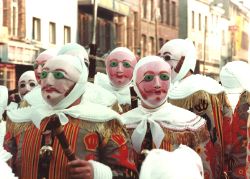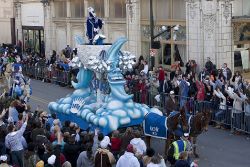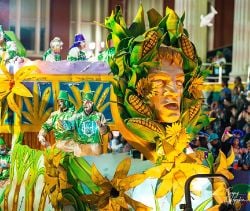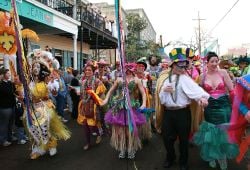Mardi Gras
| Mardi Gras | |
|---|---|
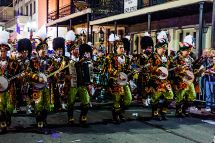
| |
| Celebrations in New Orleans, Louisiana, U.S. | |
| Also called | Fat Tuesday, Shrove Tuesday, Pancake Tuesday |
| Type | Christian, Cultural |
| Significance | Celebration period before fasting season of Lent |
| Date | Day before Ash Wednesday, 47 days before Easter |
| Celebrations | Parades, parties |
| Related to | Shrove Tuesday, Carnival, Shrove Monday, Shrovetide, Ash Wednesday, Lent, Užgavėnės, Maslenitsa, |
Mardi Gras, or Fat Tuesday, refers to events of the Carnival celebration, beginning on or after the Christian feasts of the Epiphany (Three Kings Day) and culminating on the day before Ash Wednesday, which is the beginning of Lent. Mardi Gras is French for "Fat Tuesday," reflecting the practice of the last night of eating rich, fatty foods before the ritual Lenten sacrifices and fasting of the Lenten season. This tradition is traced back to medieval Christian times in Europe.
Today, the Mardi Gras celebrations are not limited to feasts but focus more on parades, costumes, masks, and revelry. Cities with major festivities, such as New Orleans, draw large numbers of tourists to participate and enjoy the activities, often without awareness of the original religious significance.
Description
Mardi Gras, or Fat Tuesday, refers to events of the Carnival celebration, beginning on or after the Christian feasts of the Epiphany (Three Kings Day) and culminating on the day before Ash Wednesday. Mardi Gras is French for "Fat Tuesday," reflecting the practice of the last night of eating rich, fatty foods before the ritual Lenten sacrifices and fasting of the Lenten season. This it is the last day of "fat eating" or "gorging" before the fasting period of Lent.[1] Carnival translates as "farewell to meat": Carnias in carnivorous, and vale as in valediction, valedictorian, etc.[2] As this is the last day of the Christian liturgical season historically known as Shrovetide, before the penitential season of Lent, related popular practices, such as indulging in food that one might give up as their Lenten sacrifice for the upcoming forty days, are associated with the celebrations.
In countries such as the United Kingdom, Mardi Gras is known as Shrove Tuesday, which is derived from the word shrive, meaning "to administer the sacrament of confession to; to absolve."[1] Shrove Tuesday is observed by many Christians, who "make a special point of self-examination, of considering what wrongs they need to repent, and what amendments of life or areas of spiritual growth they especially need to ask God's help in dealing with."[2] As the day before the beginning of Lent, Shrove Tuesday is observed in many Christian countries through participating in confession and absolution, the ritual burning of the previous year's Holy Week palms, finalizing one's Lenten sacrifice, as well as eating pancakes and other sweets.[3] Many Christian congregations thus observe the day through the holding of pancake breakfasts, as well as the ringing of church bells to remind people to repent of their sins before the start of Lent.[3]
On Shrove Tuesday, churches also burn the palms distributed during the previous year's Palm Sunday liturgies to make the ashes used during the services held on the very next day, Ash Wednesday.[4]
History
The tradition of marking the start of Lent has been documented for centuries. Ælfric of Eynsham's "Ecclesiastical Institutes" from around 1000 C.E. states: "In the week immediately before Lent everyone shall go to his confessor and confess his deeds and the confessor shall so shrive him as he then may hear by his deeds what he is to do [in the way of penance]."[5] By the time of the late Middle Ages, the celebration of Shrovetide lasted until the start of Lent.[6] It was traditional in many societies to eat pancakes or other foods, such as fasnachts and pączki, made with the butter, eggs, and fat that would be given up during the Lenten season. The specific custom of British Christians eating pancakes on Shrove Tuesday dates to the sixteenth century.[7]
The origins of Mardi Gras can be traced to medieval Europe:
Many Old World parades celebrated a distinctive figure, the Boeuf Gras, or fatted ox, the ancient symbol of the last meat to be eaten before the beginning of the Lenten fast. Dating to medieval times, it is perhaps the modern celebration’s clearest and strongest link to the historic and traditional origins of our Carnival celebration.[8]
This traditional revelry followed France to her colonies, arriving in North America with the Le Moyne brothers, Pierre Le Moyne d'Iberville and Jean-Baptiste Le Moyne de Bienville, in the late seventeenth century, when King Louis XIV sent the pair to defend France's claim on the territory of Louisiane, which included what are now the U.S. states of Alabama, Mississippi, Louisiana and part of eastern Texas.
The expedition entered the mouth of the Mississippi River on the evening of March 2, 1699). The party proceeded upstream to a place on the east bank about 60 miles (100 km) downriver from where New Orleans is today, and made camp. Realizing it to be the eve of Mardi Gras back in France, Pierre Le Moyne d’Iberville named the spot Point du Mardi Gras (French: "Mardi Gras Point").[9]
In 1703, French settlers in Mobile established the first organized Mardi Gras celebration tradition in what was to become the United States.[10] The first informal mystic society, or krewe, "Masque de la Mobile" was formed in Mobile in 1704; it lasted until 1709. From 1711 through 1861, the Boeuf Gras Society held parades featuring a large white bull's head; later an actual bull was part of the parade.[10]
The first Mardi Gras celebrations held in New Orleans are recorded to have taken place in the 1730s. In the 1740s, Louisiana's governor, the Marquis de Vaudreuil, established elegant society balls, which became the model for the Mardi Gras balls held today.[10] The tradition in New Orleans expanded to the point that it became synonymous with the city in popular perception, and embraced by residents of New Orleans beyond those of French or Catholic heritage.
After the French-Indian War most of Louisiana was ceded to Spain in the Treaty of Paris of 1763. With this change in leadership over the region, Mardi Gras celebrations and the high society balls came to a halt. People of color were prohibited from wearing masks, feathers, and attending night time balls.[11] They continued to form organizations in which they celebrated, however.
The Louisiana purchase of 1803 granted a total of around 827,000 square miles of land to the United States for around 15 million dollars. Under early American rule, rules implemented by the Spanish continued to be upheld. After a major slave revolt in 1811, and the rise of a popular belief that spies for Aaron Burr were using masks as disguises, stricter regulations were enforced.[11] As time went on, Creoles and other members of the New Orleans community were able to convince the American Government to reinstate the balls in 1823 and later in 1827 make masking on the street legal. In 1841, the first formal parade in celebration of Mardi Gras was held. During the Civil War float building was prohibited, but people continued to march on foot in celebration. Finally, in 1875, the Louisiana State Legislature declared Mardi Gras a legal holiday in the state of Louisiana.[12]
Traditions

The festival season varies from city to city, with some traditions treating only the final three-day period before Ash Wednesday as the Mardi Gras.[13] Others, such as the one in New Orleans, consider Mardi Gras to stretch the entire period from Twelfth Night (the last night of Christmas which begins Epiphany) to Ash Wednesday.[14]
Europe
Mardi Gras as part of Carnival is also an important celebration in various Anglican and Catholic European nations.[1]
In the Czech Republic it is a folk tradition to celebrate Mardi Gras, which is called Masopust (meat-fast). There are celebration in many places including Prague[15] but the tradition also prevails in the villages such as Staré Hamry.[16]
The celebration on the same day in Germany is known by many different names, such as Schmutziger Donnerstag or Fetter Donnerstag (Fat Thursday), Unsinniger Donnerstag, Weiberfastnacht, Greesentag and others. This is often only one part of the carnival events held during one or even two weeks before Ash Wednesday, known as Karneval, Fasching, or Fastnacht depending on the region.
In Italy Mardi Gras is called Martedì Grasso (Fat Tuesday). It is the main day of Carnival (Carnevale) along with the Thursday before, called Giovedí Grasso (Fat Thursday), which begins the celebrations.[17] The most famous Carnivals in Italy are in Venice, Viareggio, and Ivrea. Ivrea has the characteristic "Battle of Oranges" that finds its roots in medieval times.
In Sweden the celebration is called Fettisdagen, when you eat fettisdagsbulle or fastlagsbulle (literally "fat Tuesday roll") also called Semla a traditional sweet roll. Originally, this was the only day one should eat this food.[18]
United States
While not observed nationally throughout the United States, a number of traditionally ethnic French cities and regions in the country have notable celebrations. While Mobile, Alabama and New Orleans, Louisiana, have the oldest and most famous celebration, other cities along the Gulf Coast with early French colonial heritage, from Pensacola, Florida; Galveston, Texas; to Lake Charles and Lafayette, Louisiana; and north to Natchez, Mississippi and Alexandria, Louisiana, have active Mardi Gras celebrations.
In the rural Acadiana area, many Cajuns celebrate with the Courir de Mardi Gras, a tradition that dates to medieval celebrations in France.[19]
St. Louis, Missouri, founded in 1764 by French fur traders, claims to host the second largest Mardi Gras celebration in the United States. The celebration is held in the historic French neighborhood, Soulard, and attracts thousands of people from around the country.[20] The city's celebration begins with "12th night," held on Epiphany, and ends on Fat Tuesday. The season is peppered with various parades celebrating the city's rich French Catholic heritage.
Mobile, Alabama
Mardi Gras is the annual Carnival celebration in Mobile, Alabama. It is the oldest annual Carnival celebration in the United States, started by Frenchman Nicholas Langlois in 1703 when Mobile was the capital of Louisiana, fifteen years before New Orleans was founded.[21] Beginning as a French Catholic tradition, Mardi Gras in Mobile has now evolved into a mainstream multi-week celebration across the spectrum of cultures in Mobile, regardless of religious affiliation.
Although Mobile has traditions of exclusive societies, with formal masked balls and elegant costumes, the celebration has evolved to become typified by public parades where members of societies, often masked, on floats or horseback, toss gifts (known as throws) to the general public. The masked balls or dances, where non-masked men wear white tie and tails (full dress or costume de rigueur) and the women wear full length evening gowns, are oriented to adults, with some mystic societies treating the balls as an extension of the debutante season of their exclusive social circles. Various nightclubs and local bars offer their own particular events.
Beyond the public parades, Mardi Gras in Mobile involves many various mystic societies, some having begun in 1704, or ending with the Civil War, while new societies were formed every century. Some mystic societies are never seen in public parades, but rather hold invitation-only events for their secret members, with private balls beginning in November, each year.
New Orleans, Louisiana
The holiday of Mardi Gras is celebrated in all of Louisiana, especially the city of New Orleans. Celebrations are concentrated for about two weeks before and through Shrove Tuesday. Usually there is one major parade each day (weather permitting); many days have several large parades. The largest and most elaborate parades take place the last five days of the Mardi Gras season. In the final week, many events occur throughout New Orleans and surrounding communities, including parades and balls (some of them masquerade balls).
The parades in New Orleans are organized by social clubs known as krewes; most follow the same parade schedule and route each year. The earliest-established krewes were the Mistick Krewe of Comus, the earliest, Rex, the Knights of Momus and the Krewe of Proteus. Several modern "super krewes" are well known for holding large parades and events, such as the Krewe of Endymion (which is best known for naming celebrities as grand marshals for their parades), the Krewe of Bacchus (similarly known for naming celebrities as their Kings), as well as the Zulu Social Aid & Pleasure Club—a predominantly African American krewe.
While many tourists center their Carnival season activities on Bourbon Street and in New Orleans and Dauphin, major parades originate in the Uptown and Mid-City districts and follow a route along St. Charles Avenue and Canal Street, on the upriver side of the French Quarter. On Mardi Gras Day, the Tuesday before Ash Wednesday, the last parades of the season wrap up and the celebrations come to a close with the "Meeting of the Courts" (known locally as the Rex Ball) between Rex and Comus.[22]
Costumes
Mardi Gras, as a celebration of life before the more-somber occasion of Ash Wednesday, is a time of fun and frivolity and nearly always involves the use of masks and costumes by its participants. In New Orleans, for example, they often take the shape of fairies, animals, people from myths, or various Medieval costumes.[23] However, many costumes today are simply elaborate creations of colored feathers and capes. The Venice tradition has brought golden masks into the usual round of costumes.[24]
Throws
Mardi Gras throws are strings of beads, doubloons, cups, or other trinkets passed out or thrown from the floats in the New Orleans Mardi Gras, the Mobile Mardi Gras and parades all throughout the Gulf Coast of the United States, to spectators lining the streets. The "throws" consist of necklaces of plastic beads, coins called doubloons, which are stamped with krewes' logos, parade themes and the year, plus an array of plastic cups and toys such as Frisbees, figurines, and trinkets. The plastic cups that are used as throws are sometimes referred to as "New Orleans dinnerware."[25]
Beads used on Mardis Gras (known as Shrove Tuesday in some regions) are purple, green, and gold, with these three colors containing the Christian symbolism of justice, faith, and power, respectively.[26]
As Fat Tuesday concludes the period of Carnival (Shrovetide), Mardis Gras beads are taken off oneself on the following day, Ash Wednesday, which begins the penitential season of Lent. One of the "solemn practices of Ash Wednesday is to pack all the beads acquired during the parade season into bags and boxes and taken them to the attic".[27]
Notes
- ↑ 1.0 1.1 1.2 Melitta Weiss Adamson and Francine Segan (eds.), Entertaining from Ancient Rome to the Super Bowl (Greenwood, 2008, ISBN 978-0313339578).
- ↑ 2.0 2.1 Darren Provine, Shrove Tuesday Retrieved September 15, 2020.
- ↑ 3.0 3.1 Alfred Heneage Cocks, The Church Bells of Buckinghamshire: Their Inscriptions, Founders, and Uses, and Traditions (Arkose Press, 2015, ISBN 978-1344077897).
- ↑ Mary Farrow, Where do Ash Wednesday ashes come from? Catholic News Agency, March 2, 2019. Retrieved September 15, 2020.
- ↑ Shrovetide Catholic Encyclopedia. Retrieved September 15, 2020.
- ↑ David Self, One Hundred Readings for Assembly (Heinemann Educational Books, 1993, ISBN 978-0435800413).
- ↑ Tony Collins, John Martin, and Wray Vamplew (eds.), Encyclopedia of Traditional British Rural Sports (Routledge, 2005, ISBN 978-0415352246).
- ↑ Stephen W. Hales, Rex - An Illustrated History of the School of Design (Arthur Hardy Enterprises, 2010, ISBN 978-0930892319).
- ↑ Jesse Greenspan, 9 Things You May Not Know About Mardi Gras History.com, September 1, 2018. Retrieved September 15, 2020.
- ↑ 10.0 10.1 10.2 Mardi Gras History Mardi Gras New Orleans. Retrieved September 15, 2020.
- ↑ 11.0 11.1 The Mardi Gras Indians AAREG, February 25, 2020. Retrieved September 15, 2020.
- ↑ Topic Guide to Mardi Gras: Significant Dates Louisiana State University Libraries. Retrieved September 15, 2020.
- ↑ Dennis Bratcher, The Season of Lent Christian Resource Institute, 2018. Retrieved September 15, 2020.
- ↑ John Wilds, Charles L. Dufour, and Walter G. Cowan, Louisiana, Yesterday and Today: A Historical Guide to the State (Louisiana State University Press, 1996, ISBN 978-0807118924).
- ↑ Mardi Gras or Masopust in Prague YouTube, January 22, 2016. Retrieved September 15, 2020.
- ↑ Staročeský Masopust Hamry Retrieved September 15, 2020.
- ↑ Charles L. Killinger, Culture and Customs of Italy (Greenwood, 2005, ISBN 978-0313324895).
- ↑ The Semla – more than just a bun Sweden Tips, January 27, 2020. Retrieved September 15, 2020.
- ↑ Barry Jean Ancelet, "Capitaine, voyage ton flag": The Traditional Cajun Country Mardi Gras (Center for Louisiana Studies, University of Southwestern Louisiana, 1989, ISBN 978-0940984462).
- ↑ Natasha Geiling, Best Places to Celebrate Mardi Gras Outside of New Orleans Smithsonian Magazine, February 12, 2018. Retrieved September 15, 2020.
- ↑ Karon Warren,The History of Mardi Gras in Mobile Alabama USA Today, February 7, 2019. Retrieved September 15, 2020.
- ↑ Rex Ball Rex. Retrieved September 15, 2020.
- ↑ Lisa Gabbert, Mardi Gras: A City's Masked Parade (The Rosen Publishing Group, 1999, ISBN 978-0823953370).
- ↑ J.C. Brown, Carnival Masks of Venice: A Photographic Essay (Artist's and Photographers' Press Ltd, 2008, ISBN 978-1904332831).
- ↑ Mardi Gras Beads & Throws Mardi Gras New Orleans. Retrieved September 15, 2020.
- ↑ Laurie A. Wilkie, Strung Out on Archaeology: An Introduction to Archaeological Research (Routledge, 2014, ISBN 978-1611322675).
- ↑ Earl J. Higgins, The Joy of Y'at Catholicism (Pelican Publishing, 2007, ISBN 978-1589804104).
ReferencesISBN links support NWE through referral fees
- Adamson, Melitta Weiss, and Francine Segan (eds.). Entertaining from Ancient Rome to the Super Bowl. Greenwood, 2008. ISBN 978-0313339578
- Ancelet, Barry Jean. "Capitaine, voyage ton flag": The Traditional Cajun Country Mardi Gras. Center for Louisiana Studies, University of Southwestern Louisiana, 1989. ISBN 978-0940984462
- Brown, J.C. Carnival Masks of Venice: A Photographic Essay. Artist's and Photographers' Press Ltd, 2008. ISBN 978-1904332831
- Cocks, Alfred Heneage. The Church Bells of Buckinghamshire: Their Inscriptions, Founders, and Uses, and Traditions. Arkose Press, 2015. ISBN 978-1344077897
- Collins, Tony, John Martin, and Wray Vamplew (eds.). Encyclopedia of Traditional British Rural Sports. Routledge, 2005. ISBN 978-0415352246
- Gabbert, Lisa. Mardi Gras: A City's Masked Parade. The Rosen Publishing Group, 1999. ISBN 978-0823953370
- Hales, Stephen W. Rex - An Illustrated History of the School of Design. Arthur Hardy Enterprises, 2010. ISBN 978-0930892319
- Higgins, Earl J. The Joy of Y'at Catholicism. Pelican Publishing, 2007. ISBN 978-1589804104
- Killinger, Charles L. Culture and Customs of Italy. Greenwood, 2005. ISBN 978-0313324895
- Self, David. One Hundred Readings for Assembly. Heinemann Educational Books, 1993. ISBN 978-0435800413
- Wilds, John, Charles L. Dufour, and Walter G. Cowan. Louisiana, Yesterday and Today: A Historical Guide to the State. Louisiana State University Press, 1996. ISBN 978-0807118924
- Wilkie, Laurie A. Strung Out on Archaeology: An Introduction to Archaeological Research. Routledge, 2014. ISBN 978-1611322675
External links
All links retrieved November 5, 2022.
- Traditional Cajun Mardi Gras Celebrations
- Where to Celebrate Mardi Gras Around the World
- Fashion plates featuring historic Mardi Gras costumes from the Metropolitan Museum of Art Libraries
| |||||||
Credits
New World Encyclopedia writers and editors rewrote and completed the Wikipedia article in accordance with New World Encyclopedia standards. This article abides by terms of the Creative Commons CC-by-sa 3.0 License (CC-by-sa), which may be used and disseminated with proper attribution. Credit is due under the terms of this license that can reference both the New World Encyclopedia contributors and the selfless volunteer contributors of the Wikimedia Foundation. To cite this article click here for a list of acceptable citing formats.The history of earlier contributions by wikipedians is accessible to researchers here:
The history of this article since it was imported to New World Encyclopedia:
Note: Some restrictions may apply to use of individual images which are separately licensed.

